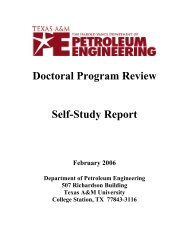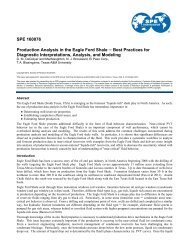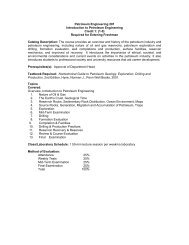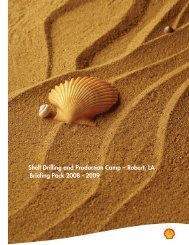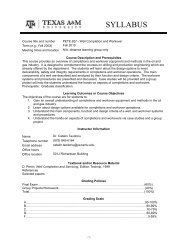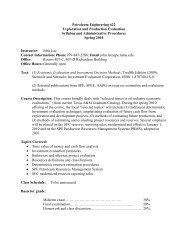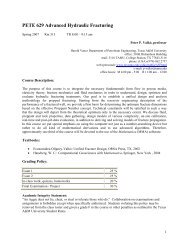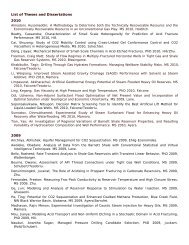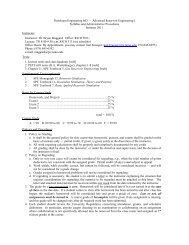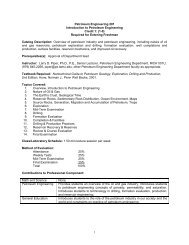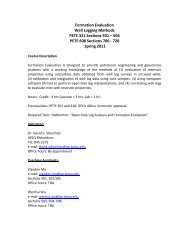Crisman Annual Report 2009 - Harold Vance Department of ...
Crisman Annual Report 2009 - Harold Vance Department of ...
Crisman Annual Report 2009 - Harold Vance Department of ...
You also want an ePaper? Increase the reach of your titles
YUMPU automatically turns print PDFs into web optimized ePapers that Google loves.
Well Spacing and Infill Drilling in Coalbed Methane Reservoirs<br />
Objectives<br />
Reservoir simulation has been used to describe<br />
the mechanism <strong>of</strong> gas desorption and diffusion in<br />
coal to reflect the response <strong>of</strong> the reservoir system<br />
and the relationship among coalbed methane<br />
reservoir properties, operation procedures, and<br />
gas production. The objective <strong>of</strong> this work is to<br />
investigate well spacing and completion design<br />
practices under various development scenarios by<br />
using reservoir simulation.<br />
In a coal bed methane reservoir there is a natural<br />
fracture system which conducts the fluid flow to the<br />
wellbore and matrix system where essentially all<br />
gas is stored. Instead <strong>of</strong> gas being compressed in<br />
the pore space, most is adsorbed on the surface <strong>of</strong><br />
it. Considering the small pore size in this reservoir<br />
system, the Klinkenberg effect or slippage factor<br />
could effect the permeability change during<br />
reservoir depletion. The amount <strong>of</strong> gas adsorbed is<br />
quantified by an adsorption curve (isotherm curve)<br />
<strong>of</strong> the Langmuir equation. As the reservoir pressure<br />
declines during production from the fracture system,<br />
gas desorbs from the coal surfaces. Flow gas from<br />
the coal matrix to the fracture system is a molecular<br />
diffusion, expressed by Fick’s law rather that Darcy’s<br />
law. Because <strong>of</strong> the adsorption curve’s convex shape,<br />
it becomes very important to attain low reservoir<br />
pressure; this is a much more important factor than<br />
in conventional reservoirs. After long dewatering,<br />
water production will decrease and gas production<br />
increase and peak after water production has<br />
significantly declined from its original rate. Predicting<br />
the time and magnitude <strong>of</strong> this peak is a large part<br />
<strong>of</strong> the early evaluation <strong>of</strong> the wells. Eventually the<br />
wells decline and have a more conventional rate<br />
pattern. In the later stage <strong>of</strong> depletion (effective<br />
fracture permeability increasing during matrix<br />
desorption at lower pressure), this rock mechanic<br />
can be described by the Palmer-Mansoori effect.<br />
Approach<br />
A reservoir simulator will be developed to determine<br />
the effect <strong>of</strong> various spacing and completion<br />
decisions on recovery for particular scenarios <strong>of</strong><br />
reservoir properties/description. The outcome <strong>of</strong><br />
the simulation and history matching will typify the<br />
reservoir <strong>of</strong> interest and will be used to develop<br />
further analysis, such as:<br />
» Determine where the Palmer-Mansoori permeability<br />
and the Klinkenberg effect are important in<br />
42<br />
reservoir mechanics<br />
» Demonstrate the importance <strong>of</strong> various parameters<br />
on spacing<br />
» Determine desirability and expected performance<br />
<strong>of</strong> either vertical or horizontal wells<br />
» Develop well spacing correlations to determine<br />
optimum well spacing for new reservoir<br />
development and guideline for several practical<br />
circumstances<br />
Accomplishments<br />
A single well, 2D, single phase reservoir simulator<br />
has been developed using Macros Visual Basic.<br />
Reservoir simulation results for different sorption<br />
pressure cases are presented in Fig. 1. The work is<br />
still being continued to accommodate multiphase,<br />
Klinkenberg effect, and Palmer-Mansoori effect.<br />
Gas Rate (SCFD)<br />
1.E+07<br />
1.E+06<br />
Project Information<br />
1.4.4 Effects <strong>of</strong> Infill Drilling Coalbed-Methane Reservoirs<br />
Contacts<br />
Bob Wattenbarger<br />
979.845.0173<br />
bob.wattenbarger@pe.tamu.edu<br />
Pahala D. Sinurat<br />
Simulation Result for Constant Pressure Case<br />
1.E+05<br />
0.1 1 10 100 1000<br />
Time (days)<br />
Sorption Pressure = 1103.20 psi<br />
Sorption Pressure = 882.56 psi<br />
Sorption Pressure = 661.92 psi<br />
Fig. 1. Reservoir simulation results for various sorption pressure.<br />
Significance<br />
Residual method can be applied in developing a<br />
reservoir simulator for coalbed methane reservoirs<br />
to provide a rapid screening approach looking at the<br />
prospect <strong>of</strong> development or purchase or production<br />
improvement.<br />
CRISMAN INSTITUTE<br />
<strong>Crisman</strong> <strong>Annual</strong> <strong>Report</strong> <strong>2009</strong>



